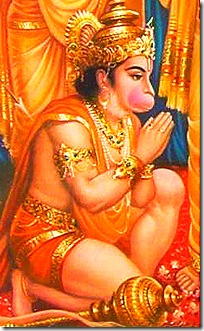 Hanuman is a Hindu god and an ardent devotee of Rama. He is a central character in the Hindu epic Ramayana and its various versions. He is also mentioned in several other texts, including Mahabharata, the various Puranas and some Jain texts. A vanara, Hanuman participated in Rama's war against the demon king Ravana. Several texts also present him as an incarnation of Lord Shiva. He is the son of Anjana and Kesari, and is also described as the son of Vayu, who according to several stories, played a role in his birth.
Hanuman is a Hindu god and an ardent devotee of Rama. He is a central character in the Hindu epic Ramayana and its various versions. He is also mentioned in several other texts, including Mahabharata, the various Puranas and some Jain texts. A vanara, Hanuman participated in Rama's war against the demon king Ravana. Several texts also present him as an incarnation of Lord Shiva. He is the son of Anjana and Kesari, and is also described as the son of Vayu, who according to several stories, played a role in his birth.
Birth and Childhood
Hanuman was born to the vanaras. His mother Anjana was an apsara who was born on earth due to a curse. She was redeemed from this curse on giving birth to a son. The Valmiki Ramayana states that his father Kesari was the son of Brihaspati, he was the King of a place named Sumeru. Anjana performed intense prayers lasting 12 long years to Shiva to get a child. Pleased with their devotion, Shiva granted them the boon they sought. Hanuman, in another interpretation, is the incarnation or reflection of Shiva himself.
Hanuman is often called the son of the deity Vayu {Wind God}; several different traditions account for the Vayu's role in Hanuman's birth. One story mentioned in Eknath's Bhavartha Ramayana (16th century CE) states that when Anjana was worshiping Shiva, the King Dasharatha of Ayodhya was also performing the ritual of Putrakama yagna in order to have children. As a result, he received some sacred pudding (payasam) to be shared by his three wives, leading to the births of Rama, Lakshmana, Bharata, and Shatrughna. By divine ordinance, a kite snatched a fragment of that pudding and dropped it while flying over the forest where Anjana was engaged in worship. Vayu, the Hindu deity of the wind, delivered the falling pudding to the outstretched hands of Anjana, who consumed it. Hanuman was born to her as a result. Another tradition says that Anjana and her husband Kesari prayed Shiva for a child. By Shiva's direction, Vayu transferred his male energy to Anjana's womb. Accordingly, Hanuman is identified as the son of the Vayu.
Another story of Hanuman's origins is derived from the Vishnu Purana and Naradeya Purana. Narada, infatuated with a princess, went to his lord Vishnu, to make him look like Vishnu, so that the princess would garland him at swayamvara (husband-choosing ceremony). He asked for hari mukh (Hari is another name of Vishnu, and mukh means face). Vishnu instead bestowed him with the face of a vanara. Unaware of this, Narada went to the princess, who burst into laughter at the sight of his ape-like face before all the king's court. Narada, unable to bear the humiliation, cursed Vishnu, that Vishnu would one day be dependent upon a vanara. Vishnu replied that what he had done was for Narada's own good, as he would have undermined his own powers if he were to enter matrimony. Vishnu also noted that Hari has the dual Sanskrit meaning of vanara. Upon hearing this, Narada repented for cursing his idol. But Vishnu told him not repent as the curse would act as a boon, for it would lead to the birth of Hanuman, an avatar of Shiva, without whose help Rama (Vishnu's avatar) could not kill Ravana.
Another story of Hanuman's origin tries to link various stories. As per this, Hanuman is the son of Shiva and Mohini, where Mohini is the female form of Vishnu. The resulting energy was stored in sacred form. When Anjana and Kesari worshiped Shiva for a son, Shiva asked Vayu to place the energy inside Anjana's womb. Some stories justify, this is why Hanuman was so powerful and devoted to Rama so much. This is in contrast to the story of Ayyappa and is still a point of discussion.
Childhood
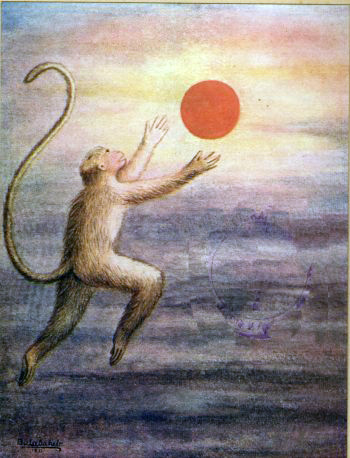 As a child, believing the sun to be a ripe mango, Hanuman pursued it in order to eat it. Rahu, a Vedic planet corresponding to an eclipse, was at that time seeking out the sun as well, and he clashed with Hanuman. Hanuman thrashed Rahu and went to take the sun in his mouth. Rahu approached Indra, king of devas, and complained that a monkey child stopped him from taking on Sun, preventing the scheduled eclipse. This enraged Indra, who responded by throwing the Vajra (thunderbolt) at Hanuman, which struck his jaw. He fell back down to the earth and became unconscious. A permanent mark was left on his chin , due to impact of Vajra, explaining his name. Upset over the attack, Hanuman's father figure Vayu deva (the deity of air) went into seclusion, withdrawing air along with him. As living beings began to asphyxiate, Indra withdrew the effect of his thunderbolt. The devas then revived Hanuman and blessed him with multiple boons to appease Vayu.
As a child, believing the sun to be a ripe mango, Hanuman pursued it in order to eat it. Rahu, a Vedic planet corresponding to an eclipse, was at that time seeking out the sun as well, and he clashed with Hanuman. Hanuman thrashed Rahu and went to take the sun in his mouth. Rahu approached Indra, king of devas, and complained that a monkey child stopped him from taking on Sun, preventing the scheduled eclipse. This enraged Indra, who responded by throwing the Vajra (thunderbolt) at Hanuman, which struck his jaw. He fell back down to the earth and became unconscious. A permanent mark was left on his chin , due to impact of Vajra, explaining his name. Upset over the attack, Hanuman's father figure Vayu deva (the deity of air) went into seclusion, withdrawing air along with him. As living beings began to asphyxiate, Indra withdrew the effect of his thunderbolt. The devas then revived Hanuman and blessed him with multiple boons to appease Vayu.
Brahma gave Hanuman a boon that would protect him from the irrevocable Brahma's curse. Brahma also said: "Nobody will be able to kill you with any weapon in war." From Brahma he obtained the power of inducing fear in enemies, of destroying fear in friends, to be able to change his form at will and to be able to easily travel wherever he wished. From Shiva he obtained the boons of longevity, scriptural wisdom and ability to cross the ocean. Shiva assured safety of Hanuman with a band that would protect him for life. Indra blessed him that the Vajra weapon will no longer be effective on him and his body would become stronger than Vajra. Varuna blessed baby Hanuman with a boon that he would always be protected from water. Agni blessed him with immunity to burning by fire. Surya gave him two siddhis of yoga namely "laghima" and "garima", to be able to attain the smallest or to attain the biggest form. Yama, the God of Death blessed him healthy life and free from his weapon danda, thus death would not come to him. Kubera showered his blessings declaring that Hanuman would always remain happy and contented. Vishwakarma blessed him that Hanuman would be protected from all his creations in the form of objects or weapons. Vayu also blessed him with more speed than he himself had. Kamadeva also blessed him that the appeal of sex will not be effective on him. So his name is also Bala Bramhachari.
On ascertaining Surya to be an all-knowing teacher, Hanuman raised his body into an orbit around the sun and requested to Surya to accept him as a student. Surya refused and explained claiming that he always had to be on the move in his chariot, it would be impossible for Hanuman to learn well. Undeterred, Hanuman enlarged his form, with one leg on the eastern ranges and the other on the western ranges, and facing Surya again pleaded. Pleased by his persistence, Surya agreed. Hanuman then learned all of the latter's knowledge. When Hanuman then requested Surya to quote his "guru-dakshina" (teacher's fee), the latter refused, saying that the pleasure of teaching one as dedicated as him was the fee in itself. Hanuman insisted, whereupon Surya asked him to help his (Surya's) spiritual son Sugriva. Hanuman's choice of Surya as his teacher is said to signify Surya as a Karma Saakshi, an eternal witness of all deeds. Hanuman later became Sugriva's minister.
Hanuman was mischievous in his childhood, and sometimes teased the meditating sages in the forests by snatching their personal belongings and by disturbing their well-arranged articles of worship. Hanuman when he was young once looked at the Sun and thought it was a ripe mango and flew towards it to eat it. Finding his antics unbearable, but realizing that Hanuman was but a child, (albeit invincible), the sages placed a mild curse on him by which he became unable to remember his own ability unless reminded by another person. The curse is highlighted in Kishkindha Kanda and he was relieved from the curse by the end of Kishkindha Kanda when Jambavantha reminds Hanuman of his abilities and encourages him to go and find Sita and in Sundara Kanda he used his supernatural powers at his best.
Meeting with Rama
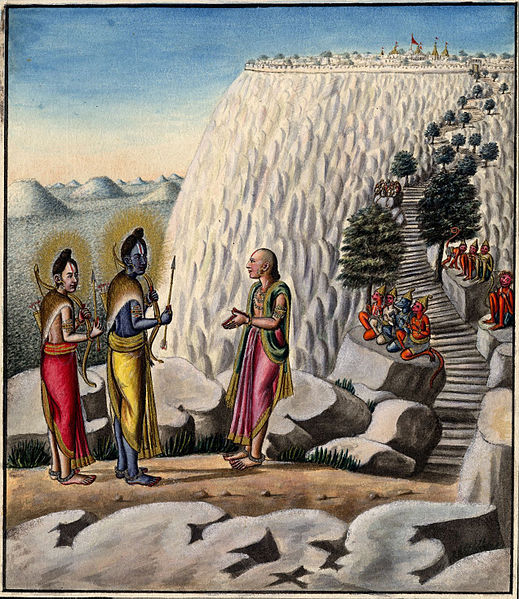 Hanuman meets Rama during the Rama's 14-year exile.[21] With his brother Lakshmana, Rama is searching for his wife Sita who had been abducted by Ravana. Their search brings them to the vicinity of the mountain Rishyamukha, where Sugriva, along with his followers and friends, are in hiding from his older brother Vali.
Hanuman meets Rama during the Rama's 14-year exile.[21] With his brother Lakshmana, Rama is searching for his wife Sita who had been abducted by Ravana. Their search brings them to the vicinity of the mountain Rishyamukha, where Sugriva, along with his followers and friends, are in hiding from his older brother Vali.
Having seen Rama and Lakshmana, Sugriva sends Hanuman to ascertain their identities. Hanuman approaches the two brothers in the guise of a brahmin. His first words to them are such that Rama says to Lakshmana that none could speak the way the brahmin did unless he or she had mastered the Vedas. He notes that there is no defect in the brahmin's countenance, eyes, forehead, brows, or any limb. He points out to Lakshmana that his accent is captivating, adding that even an enemy with sword drawn would be moved. He praises the disguised Hanuman further, saying that sure success awaited the king whose emissaries were as accomplished as he was.
When Rama introduces himself, the brahman identitifies himself as Hanuman and falls prostrate before Rama, who embraces him warmly. Thereafter, Hanuman's life becomes interwoven with that of Rama. Hanuman then brings about friendship and alliance between Rama and Sugriva; Rama helps Sugriva regain his honour and makes him king of Kishkindha. Sugriva and his vanaras, most notably Hanuman, help Rama defeat Raavana and reunite with Sita.
In their search for Sita, a group of Vanaras reaches the southern seashore. Upon encountering the vast ocean, every vanara begins to lament his inability to jump across the water. Hanuman too is saddened at the possible failure of his mission, until the other vanaras and the wise bear Jambavantha begin to extol his virtues. Hanuman then recollects his own powers, enlarges his body, and flies across the ocean. On his way, he encounters a mountain that rises from the sea, proclaims that it owed his father a debt, and asks him to rest a while before proceeding. Not wanting to waste any time, Hanuman thanks the mountain, touches it briefly, and presses on. He then encounters a goddess disguised as a sea-monster, Surasa, who challenges him to enter her mouth. When Hanuman outwits her, she admits that her challenge was merely a test of his courage. After killing Simhika, a rakshasi, he reaches Lanka.
Finding Sita
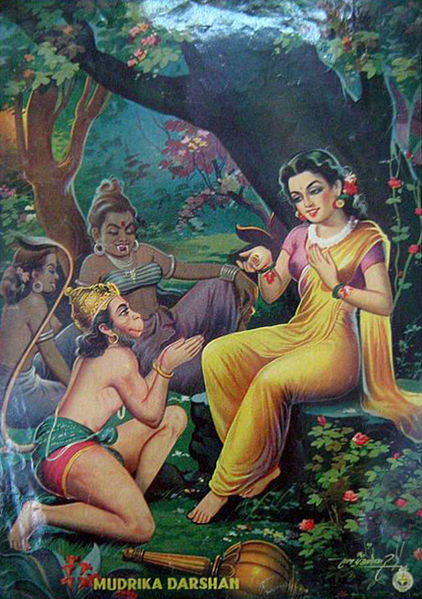 Hanuman reaches Lanka through flight and marvels at its beauty. After he finds Sita in captivity in a garden, Hanuman reveals his identity to her, reassures her that Rama has been looking for her, and uplifts her spirits. He offers to carry her back to Rama, but she refuses his offer, saying it would be an insult to Rama as his honour is at stake. In order to give Sita faith, Hanuman gives her a ring that Rama wanted Hanuman to give her. After meeting Sita, Hanuman begins to wreak havoc, gradually destroying the palaces and properties of Lanka. He kills many rakshasas, including Jambumali and Aksha Kumar. To subdue him, Ravana's son Indrajit uses the Brahmastra. Though immune to the effects of this weapon Hanuman, out of respect to Brahma, allows himself be bound. Deciding to use the opportunity to meet Ravana, and to assess the strength of Ravana's hordes, Hanuman allows the rakshasa warriors to parade him through the streets. He conveys Rama's message of warning and demands the safe return of Sita. He also informs Ravana that Rama would be willing to forgive him if he returns Sita honourably.
Hanuman reaches Lanka through flight and marvels at its beauty. After he finds Sita in captivity in a garden, Hanuman reveals his identity to her, reassures her that Rama has been looking for her, and uplifts her spirits. He offers to carry her back to Rama, but she refuses his offer, saying it would be an insult to Rama as his honour is at stake. In order to give Sita faith, Hanuman gives her a ring that Rama wanted Hanuman to give her. After meeting Sita, Hanuman begins to wreak havoc, gradually destroying the palaces and properties of Lanka. He kills many rakshasas, including Jambumali and Aksha Kumar. To subdue him, Ravana's son Indrajit uses the Brahmastra. Though immune to the effects of this weapon Hanuman, out of respect to Brahma, allows himself be bound. Deciding to use the opportunity to meet Ravana, and to assess the strength of Ravana's hordes, Hanuman allows the rakshasa warriors to parade him through the streets. He conveys Rama's message of warning and demands the safe return of Sita. He also informs Ravana that Rama would be willing to forgive him if he returns Sita honourably.
Enraged, Ravana orders Hanuman's execution, whereupon Ravana's brother Vibhishana intervenes, pointing out that it is against the rules of engagement to kill a messenger. Ravana then orders Hanuman's tail be lit afire. As Ravana's forces attempted to wrap cloth around his tail, Hanuman begins to lengthen it. After frustrating them for a while, he allows it to burn, then escapes from his captors, and with his tail on fire he burns down large parts of Lanka. After extinguishing his flaming tail in the sea, he returns to Rama.
Shapeshifting
In the Ramayana Hanuman changes shape several times. For example, while he searches for the kidnapped Sita in Ravana's palaces on Lanka, he contracts himself to the size of a cat, so that he will not be detected by the enemy. Later on, he takes on the size of a mountain, blazing with radiance, to show his true power to Sita.
Also he enlarges & immediately afterwards contracts his body to out-wit Surasa, the she-demon, who blocked his path while crossing the sea to reach Lanka. Again, he turns his body microscopically small to enter Lanka before killing Lankini, the she-demon guarding the gates of Lanka.He achieved this shape-shifting by the powers of two siddhis; Anima and Garima bestowed upon him in his childhood by Sun-God, Surya.
Mountain Lifting
When Lakshmana is severely wounded during the battle against Ravana, Hanuman is sent to fetch the Sanjivani, a powerful life-restoring herb, from Dronagiri mountain in the Himalayas, to revive him. Ravana realises that if Lakshmana dies, a distraught Rama would probably give up, and so he dispatches the sorcerer Kalanemi to intercept Hanuman. Kalanemi, in the guise of a sage, deceives Hanuman, but Hanuman uncovers his plot with the help of an apsara, whom he rescues from her accursed state as a crocodile.
Ravana, upon learning that Kalanemi has been slain by Hanuman, summons Surya to rise before its appointed time because the physician Sushena had said that Lakshmana would perish if untreated by daybreak. Hanuman realizes the danger, however, and, becoming many times his normal size, detains the Sun God to prevent the break of day. He then resumes his search for the precious herb, but, when he finds himself unable to identify which herb it is, he lifts the entire mountain and delivers it to the battlefield in Lanka. Sushena then identifies and administers the herb, and Lakshmana is saved. Rama embraces Hanuman, declaring him as dear to him as his own brother. Hanuman releases Surya from his grip, and asks forgiveness, as the Sun was also his Guru.
Hanuman was also called "langra veer"; langra in Hindi means limping and veer means "brave". The story behind Hanuman being called langra is as follows. He was injured when he was crossing the Ayodhya with the mountain in his hands. As he was crossing over Ayodhya, Bharat, Rama's young brother, saw him and assumed that some Rakshasa was taking this mountain to attack Ayodhya. Bharat then shot Hanuman with an arrow, which was engraved with Rama's name. Hanuman did not stop this arrow as it had Rama's name written on it, and it injured his leg. Hanuman landed and explained to Bharat that he was moving the mountain to save his own brother, Lakshmana. Bharat, very sorry, offered to fire an arrow to Lanka, which Hanuman could ride in order to reach his destination more easily. But Hanuman declined the offer, preferring to fly on his own, and he continued his journey with his injured leg.
Patala incident
In another incident during the war, Rama and Lakshmana are captured by the rakshasa Mahiravana and Ahiravan, brother of Ravana, who held them captive in their palace in Patala (or Patalpuri) --the netherworld. Mahiravana keeps them as offerings to his deity. Searching for them, Hanuman reaches Patala, the gates of which are guarded by a young creature called Makardhwaja (known also as Makar-Dhwaja or Magar Dhwaja), who is part reptile and part Vanara.
The story of Makardhwaja's birth is said to be that when Hanuman extinguished his burning tail in the ocean, a drop of his sweat fell into the waters, eventually becoming Makardhwaja, who perceives Hanuman as his father. When Hanuman introduces himself to Makardhwaja, the latter asks his blessings. Hanuman enters Patala.
Upon entering Patala, Hanuman discovers that to kill Mahiravana, he must simultaneously extinguish five lamps burning in different directions. Hanuman assumes the Panchamukha or five-faced form of Sri Varaha facing north, Sri Narasimha facing south, Sri Garuda facing west, Sri Hayagriva facing the sky and his own facing the east, and blows out the lamps. Hanuman then rescues Rama and Lakshmana. Afterwards, Rama asks Hanuman to crown Makardhwaja king of Patala. Hanuman then instructs Makardhwaja to rule Patala with justice and wisdom.
To date Chandraloak Devpuri mandir is located at Dugana a small village 17 km from Laharpur, Sitapur district, Uttar Pradesh. A divine place where Chakleswar Mahadev situated.
Honours
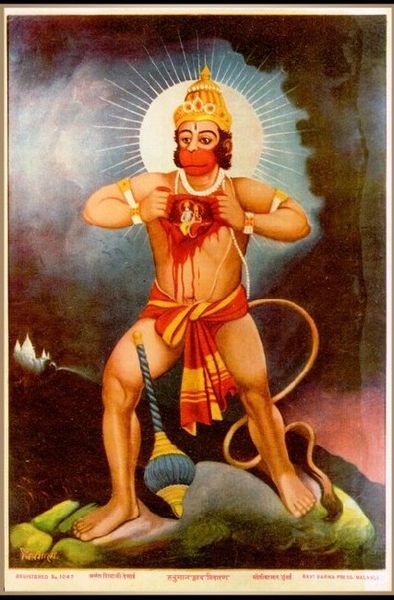 Shortly after he is crowned Emperor upon his return to Ayodhya, Rama decides to ceremoniously reward all his well-wishers. At a grand ceremony in his court, all his friends and allies take turns being honoured at the throne. Hanuman approaches without desiring a reward. Seeing Hanuman come up to him, an emotionally overwhelmed Rama embraces him warmly, declaring that he could never adequately honour or repay Hanuman for the help and services he received from the noble Vanara. Sita, however, insists that Hanuman deserved honour more than anyone else, and Sita gives him a necklace of precious stones adorning her neck.
Shortly after he is crowned Emperor upon his return to Ayodhya, Rama decides to ceremoniously reward all his well-wishers. At a grand ceremony in his court, all his friends and allies take turns being honoured at the throne. Hanuman approaches without desiring a reward. Seeing Hanuman come up to him, an emotionally overwhelmed Rama embraces him warmly, declaring that he could never adequately honour or repay Hanuman for the help and services he received from the noble Vanara. Sita, however, insists that Hanuman deserved honour more than anyone else, and Sita gives him a necklace of precious stones adorning her neck.
When he receives it, Hanuman immediately takes it apart, and peers into each stone. Taken aback, many of those present demand to know why he is destroying the precious gift. Hanuman answers that he was looking into the stones to make sure that Rama and Sita are in them, because if they are not, the necklace is of no value to him. At this, a few mock Hanuman, saying his reverence and love for Rama and Sita could not possibly be as deep as he implies. In response, Hanuman tears his chest open, and everyone is stunned to see Rama and Sita literally in his heart.
Hanuman Ramayana
After the victory of Rama over Ravana, Hanuman went to the Himalayas. There he scripted a version of the Ramayana on the Himalayan mountains using his nails, recording every detail of Rama's deeds. When Maharishi Valmiki visited him to show him his own version of the Ramayana, he saw Hanuman's version and became very disappointed.
When Hanuman asked Valmiki the cause of his sorrow, the sage said that his version, which he had created very laboriously, was no match for the splendour of Hanuman's, and would therefore go ignored. At this, Hanuman discarded his own version, which is called the Hanumad Ramayana. Maharishi Valmiki was so taken aback that he said he would take another birth to sing the glory of Hanuman which he had understated in his version.
Later, one tablet is said to have floated ashore during the period of Mahakavi Kalidasa, and hung at a public place to be deciphered by scholars. Kalidasa is said to have deciphered it and recognised that it was from the Hanumad Ramayana recorded by Hanuman in an extinct script, and considered himself very fortunate to see at least one pada of the stanza.
After the Ramayana war
After the war, and after reigning for several years, the time arrived for Rama to depart to his supreme abode Vaikuntha. Many of Rama's entourage, including Sugriva, decided to depart with him. Hanuman, however, requested from Rama that he will remain on earth as long as Rama's name was venerated by people. Sita accorded Hanuman that desire, and granted that his image would be installed at various public places, so he could listen to people chanting Rama's name. He is one of the immortals (Chiranjivi) of Hinduism.
Mahabharata
 Hanuman is also considered to be the brother of Bhima, on the basis of their having the same father, Vayu. During the Pandavas' exile, he appears disguised as a weak and aged monkey to Bhima in order to subdue his arrogance. Bhima enters a field where Hanuman is lying with his tail blocking the way. Bhima, unaware of his identity, tells him to move it out of the way. Hanuman, incognito, refuses. Bhima then tries to move the tail himself but he is unable, despite his great strength. Realising he is no ordinary monkey, he inquires as to Hanuman's identity, which is then revealed. At Bhima's request, Hanuman is also said to have enlarged himself to demonstrate the proportions he had assumed in his crossing of the sea as he journeyed to Lanka and also said that when the war came, he would be there to protect the Pandavas. Pandupole is claimed as the place where this meeting happened.
Hanuman is also considered to be the brother of Bhima, on the basis of their having the same father, Vayu. During the Pandavas' exile, he appears disguised as a weak and aged monkey to Bhima in order to subdue his arrogance. Bhima enters a field where Hanuman is lying with his tail blocking the way. Bhima, unaware of his identity, tells him to move it out of the way. Hanuman, incognito, refuses. Bhima then tries to move the tail himself but he is unable, despite his great strength. Realising he is no ordinary monkey, he inquires as to Hanuman's identity, which is then revealed. At Bhima's request, Hanuman is also said to have enlarged himself to demonstrate the proportions he had assumed in his crossing of the sea as he journeyed to Lanka and also said that when the war came, he would be there to protect the Pandavas. Pandupole is claimed as the place where this meeting happened.
During the great battle of Kurukshetra, Arjuna entered the battlefield with a flag displaying Hanuman on his chariot. The incident that led to this was an earlier encounter between Hanuman and Arjuna, wherein Hanuman appeared as a small talking monkey before Arjuna at Rameshwaram, where Rama had built the great bridge to cross over to Lanka to rescue Sita. Upon Arjuna's wondering aloud at Rama's taking the help of monkeys rather than building a bridge of arrows, Hanuman challenged him to build a bridge capable of bearing him alone; Arjuna, unaware of the vanara's true identity, accepted. Hanuman then proceeded to repeatedly destroy the bridges made by Arjuna, who decided to take his own life. Krishna smiled and placed his divine discus beneath the bridge, and this time Hanuman could no longer break it.Vishnu then appeared before them both after originally coming in the form of a tortoise, chiding Arjuna for his vanity and Hanuman for making Arjuna feel incompetent. As an act of penitence, Hanuman decided to help Arjuna by stabilizing and strengthening his chariot during the imminent great battle. But during the great battle between Karna and Arjuna, even Hanuman failed to stabilize the chariot of Arjuna and Lord Krishna praised Karna for this feat. After, the battle of Kurukshetra was over, Krishna asked Arjuna, that today you step down the chariot before me. After Arjuna got down, Krishna followed him and thanked Hanuman for staying with them during the whole fight in the form of a flag on the chariot. Hanuman came in his original form, bowed to Krishna and left the flag, flying away into the sky. As soon as he left the flag, the chariot began to burn and turned into ashes. Arjuna was shocked to see this, then Krishna told Arjuna, that the only reason his chariot was still standing was because of the presence of Himself and Hanuman, otherwise, it would have burnt many days ago due to effects of celestial weapons thrown at it in the war.
According to legend, Hanuman is one of the four people to have heard the Bhagwad Gita from Krishna and seen his Vishvarupa (universal) form, the other three being Arjuna, Sanjaya and Barbarika, son of Ghatotkacha and also Karna at the time of his death.